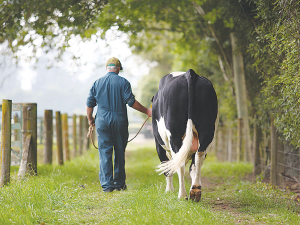2024/25 Dairy Statistics: NZ dairy farmers boost production with fewer cows
According to the New Zealand Dairy Statistics 2024/25 report, New Zealand dairy farmers are achieving more with fewer cows.
 LIC says long-term users of its genetics have almost doubled the speed of improvement in their herds over the last decade.
LIC says long-term users of its genetics have almost doubled the speed of improvement in their herds over the last decade.
Farmer-owned LIC says the goal of being both sustainable and profitable is well within reach for New Zealand dairy farmers
Releasing its second annual Sustainability Report, the co-operative noted that farmers with a sharpened focus on herd improvement were already making great strides.
LIC chair Murray King says while the co-op’s focus on sustainability is not new, sustainability reporting is an evolving area for LIC, as it is for many other businesses.
“This is our second year reporting on our sustainability journey and it’s fantastic to see the progress we have made towards our goal of becoming carbon neutral by 2050,” says King.
One of the highlights of the report is that farmers are breeding better cows faster.
It points out that longterm users of LIC genetics have almost doubled the speed of improvement in their herds over the last decade, allowing them to breed better cows – which produce more and are more emissions- efficient – at a much faster rate.
“We’re helping farmers breed better cows and get the best from them,” it says.
“As part of our commitment to faster genetic gain, this year our team of scientists investigated the full spectrum of MINDA herds in search of the ‘best cows’ and whether a clear correlation existed between breeding worth (BW) and milk production efficiency.
“The research reaffirms that the best cows (with high BW) are more efficient at turning feed into milk – they produce more and are more emissions efficient.”
LIC says to help the dairy sector meet its environmental goals, NZ farmers must breed more of those highly efficient cows that sit at the top, and fewer of those who sit at the bottom.
It notes that at an individual farm level there can be many variable factors, but it is conceivable that by 2030 a farmer’s whole herd could be performing at the level of their top 25% cows today.
“Breeding the best cows, faster, is key to helping farmers solve the challenge of being profitable and sustainable.”
After assessing genetic data, LIC estimates that over the past 32 years (from 1990 to 2022) the genetic improvement its Premier Sires artificial breeding bull teams delivered on-farm has resulted in a 12% reduction in enteric methane and 14.5% less urinary nitrogen emitted per kgMS.
The report states that during the 2021-22 season, LIC has delivered more methane efficient genetics to farmers than any other year.
“The increased rate of genetic improvement in production and fertility traits without any increase in animal size, and the shorter generation interval that genomic selection enables has created a consistent trend of NZ farmers breeding more emissions efficient cows, and year-on-year they’re doing it faster.”
The report also notes that LIC recorded an overall reduction in its total carbon dioxide emissions of 16.3% when comparing 2021/22 with its base year (2018/19), excluding biogenic methane.
LIC’s 2021-22 biogenic methane has decreased by 11.93% from base year.
Effective from 1 January 2026, there will be three new grower directors on the board of the Foundation for Arable Research (FAR).
The National Wild Goat Hunting Competition has removed 33,418 wild goats over the past three years.
New Zealand needs a new healthcare model to address rising rates of obesity in rural communities, with the current system leaving many patients unable to access effective treatment or long-term support, warn GPs.
Southland farmers are being urged to put safety first, following a spike in tip offs about risky handling of wind-damaged trees
Third-generation Ashburton dairy farmers TJ and Mark Stewart are no strangers to adapting and evolving.
When American retail giant Cosco came to audit Open Country Dairy’s new butter plant at the Waharoa site and give the green light to supply their American stores, they allowed themselves a week for the exercise.

OPINION: Your old mate welcomes the proposed changes to local government but notes it drew responses that ranged from the reasonable…
OPINION: A press release from the oxygen thieves running the hot air symposium on climate change, known as COP30, grabbed your…